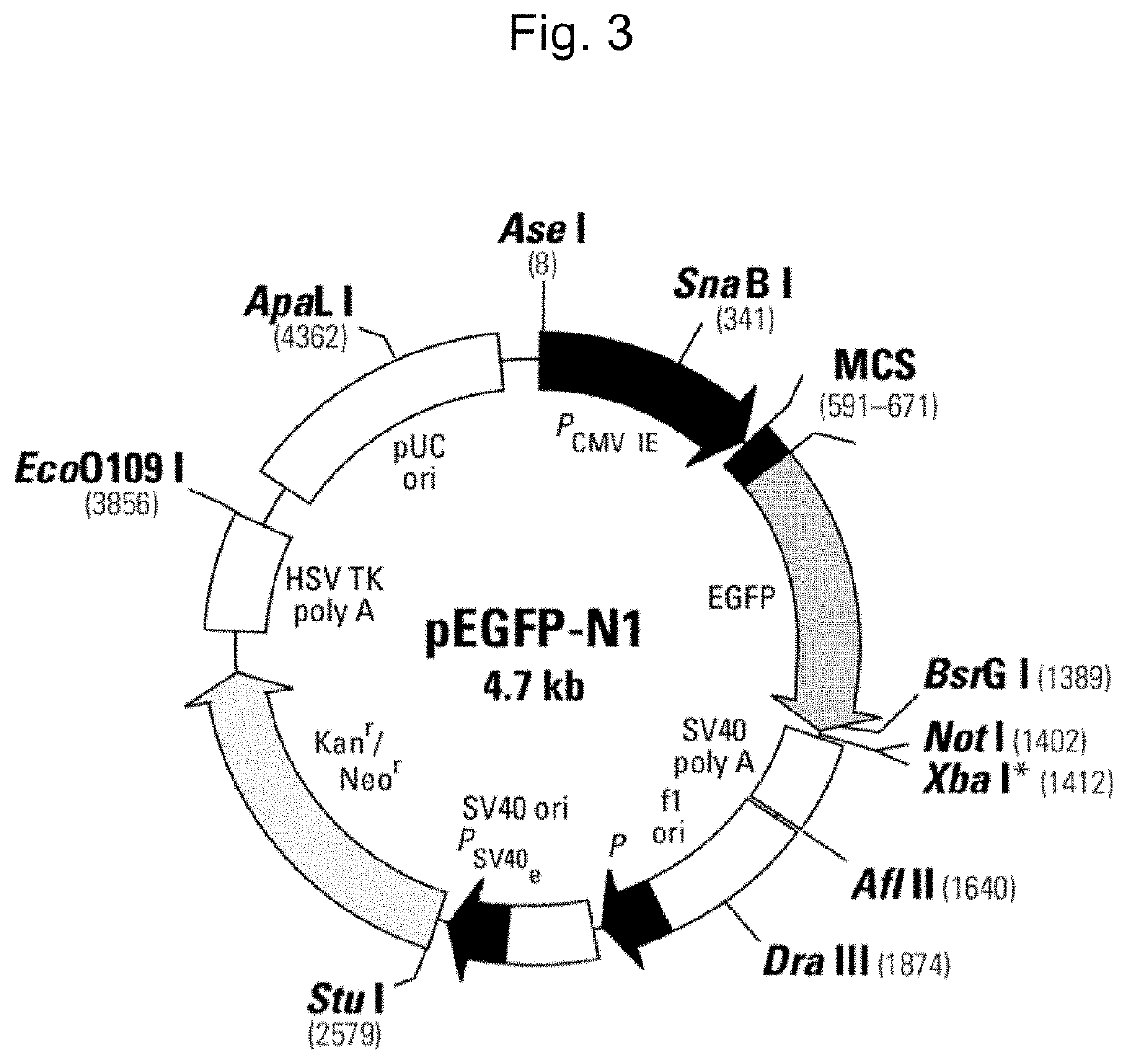Novel eukaryotic cell transfection systems and related methods
a cell transfection and eukaryotic technology, applied in general culture methods, invertebrate cells, genetically modified cells, etc., can solve the problems of specialized equipment and techniques, labor and time, and specialized equipment, and achieve robust transfection efficiency, reduce the number of steps required to transfect cells, and reduce the number of steps.
- Summary
- Abstract
- Description
- Claims
- Application Information
AI Technical Summary
Benefits of technology
Problems solved by technology
Method used
Image
Examples
example 1
PEI Pre-Conditioned CHO Cell Transfection Medium
[0387]A. CHOM4Tx®: a PEI Pre-Conditioned Cell Transfection Medium
[0388]Immediately after preparation, CHOM4Tx®™ was filter-sterilized through a 0.22 pm filter (Millipore #SCGPT05RE) and stored at 4° C. or −20° C. until use. In certain instances, the medium was aliquoted into eight 10 ml and 100 ml volumes prior to storage.
[0389]B. CHOM4Tx®-1™ is a PEI Pre-Conditioned Cell Transfection Medium
[0390]Immediately after preparation, CHOM4Tx®-1 transfection medium was filter-sterilized through a 0.22 μm filter (Millipore #SCGPT05RE) and stored at 4° C. or −20° C. until use. In certain instances, the medium was aliquoted into eight 10 mL and 100 mL volumes prior to storage.
[0391]C. Preparation of PEI Solution
[0392]500 ml UHP water was added into an endotoxin-free, sterile 1 Liter bottle. The liquid was stirred with the help of a pre-sterilized magnetic bar. 1000 mg in weight of PEI was added into the liquid (note: the aggregated consistency of...
example 2
Highly-Efficient Transient Transfection of CHO Cells Using PEI Pre-Conditioned Cell Transfection Media
[0398]A. Preparation of CHOExpress™, CHO-S, or CHO-K1 Seed Train Cell Cultures
[0399]Seed train CHOExpress™, CHO-S, or CHO-K1 cells actively growing in ProCHO5™ medium (Lonza, CAT #BE02-041Q) at 37° C., 5% CO2, and 90% humidity with shaking (180 RPM) were used. Cell density was determined and a volume containing approximately 0.5×106 cells / ml was removed, centrifuged for 3-5 minutes at 3000×g, and the pelleted cells resuspended in fresh, pre-warmed (37° C.) ProCHO5™ medium (Lonza, CAT #BE02-041Q). The cells were grown for 3 days at 37° C., 5% CO2, and 90% humidity with shaking (180 RPM), to reach a density of approximately 3.5×106 cells / ml.
[0400]B. Preparation of Cells for Transfection
[0401]On day three, approximately 24 hours before cell transfection, the density of the seed train cells was determined. A volume of cells containing approximately 2×106 cells / ml was removed, centrifuge...
example 3
Highly-Efficient Transient Transfection of CHO Cells Using Stored PEI pre-Conditioned Cell Transfection Medium
[0419]A. Preparation of Seed Train Cell Cultures
[0420]Seed train CHOExpress™, CHO-S, or CHO-K1 cells actively growing in ProCHO5™ medium (Lonza, CAT #BE02-041Q) were prepared and used as described. CHOExpress™ cells were also cultured in seed trains in ExcellGene's chemically defined FlexiCHO® medium.
[0421]B. Preparation of Cells for Transfection
[0422]CHOExpress™, CHO-S, or CHO-K1 cells collected from the seed train cells were prepared as described. For each transfection, the appropriate volume of cells was removed, centrifuged, and resuspended in 2 ml or 4 ml of previously frozen and thawed CHOM4Tx® medium or CHOM4Tx®-1™ medium.
[0423]C. Transfection
[0424]Plasmid DNA containing the gene of interest was previously produced in E.coli bacteria and purified as described above.
[0425]For a 5 ml transfection, approximately 24 μl of the purified DNA solution, i.e., approximately 24 ...
PUM
| Property | Measurement | Unit |
|---|---|---|
| temperature | aaaaa | aaaaa |
| concentration | aaaaa | aaaaa |
| concentration | aaaaa | aaaaa |
Abstract
Description
Claims
Application Information
 Login to View More
Login to View More - R&D
- Intellectual Property
- Life Sciences
- Materials
- Tech Scout
- Unparalleled Data Quality
- Higher Quality Content
- 60% Fewer Hallucinations
Browse by: Latest US Patents, China's latest patents, Technical Efficacy Thesaurus, Application Domain, Technology Topic, Popular Technical Reports.
© 2025 PatSnap. All rights reserved.Legal|Privacy policy|Modern Slavery Act Transparency Statement|Sitemap|About US| Contact US: help@patsnap.com



